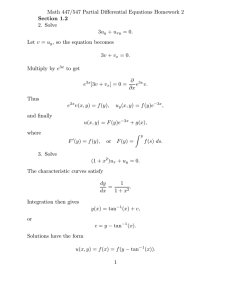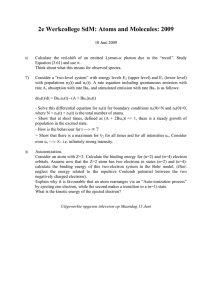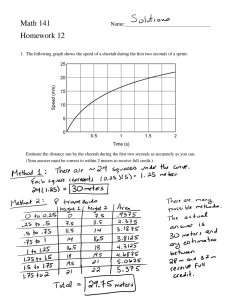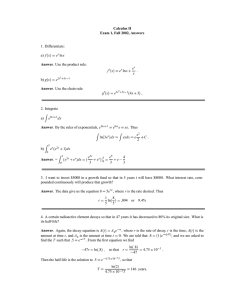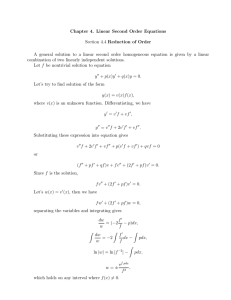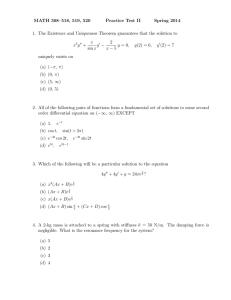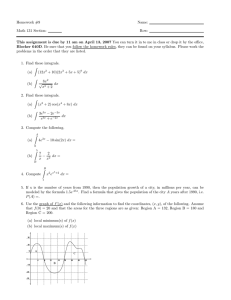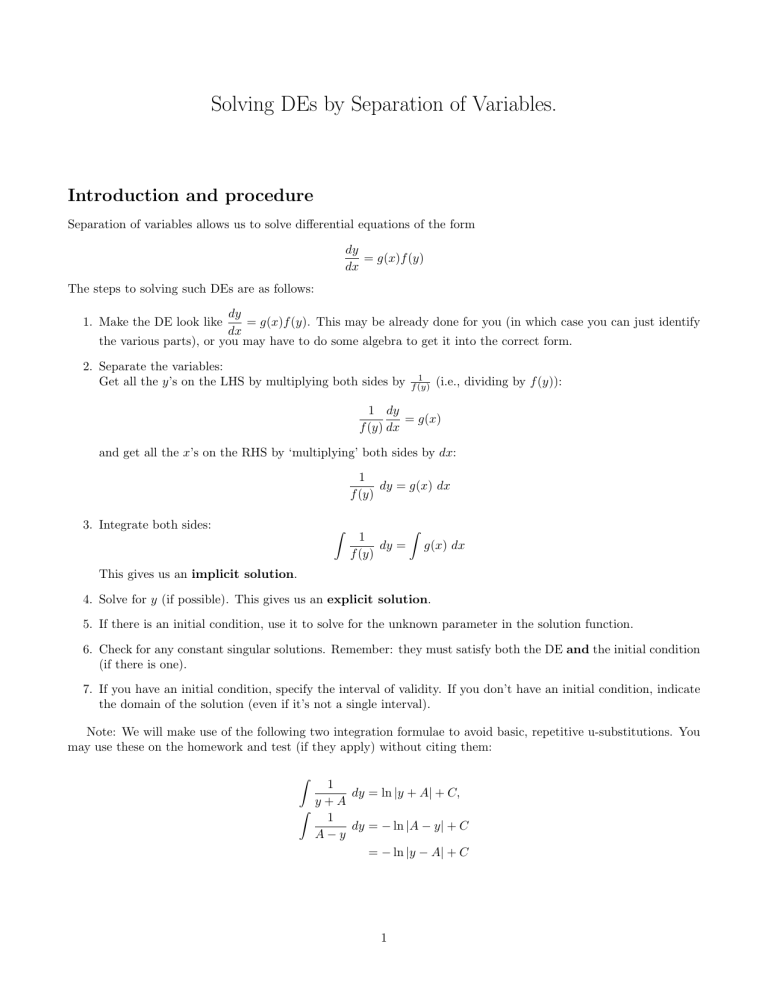
Solving DEs by Separation of Variables.
Introduction and procedure
Separation of variables allows us to solve differential equations of the form
dy
= g(x)f (y)
dx
The steps to solving such DEs are as follows:
dy
= g(x)f (y). This may be already done for you (in which case you can just identify
dx
the various parts), or you may have to do some algebra to get it into the correct form.
1. Make the DE look like
2. Separate the variables:
Get all the y’s on the LHS by multiplying both sides by
1
f (y)
(i.e., dividing by f (y)):
1 dy
= g(x)
f (y) dx
and get all the x’s on the RHS by ‘multiplying’ both sides by dx:
1
dy = g(x) dx
f (y)
3. Integrate both sides:
Z
1
dy =
f (y)
Z
g(x) dx
This gives us an implicit solution.
4. Solve for y (if possible). This gives us an explicit solution.
5. If there is an initial condition, use it to solve for the unknown parameter in the solution function.
6. Check for any constant singular solutions. Remember: they must satisfy both the DE and the initial condition
(if there is one).
7. If you have an initial condition, specify the interval of validity. If you don’t have an initial condition, indicate
the domain of the solution (even if it’s not a single interval).
Note: We will make use of the following two integration formulae to avoid basic, repetitive u-substitutions. You
may use these on the homework and test (if they apply) without citing them:
Z
1
dy = ln |y + A| + C,
y+A
Z
1
dy = − ln |A − y| + C
A−y
= − ln |y − A| + C
1
Examples
Example 1. Find an implicit solution of the IVP
y0 =
xy + 2y − x − 2
,
xy − 3y + x − 3
y(4) = 2
1. Rewriting the LHS in differential form and factoring the RHS we get
dy
(x + 2)(y − 1)
=
dx
(x − 3)(y + 1)
2. Separating the variables leads to:
x+2
y+1
dy =
dx
y−1
x−3
3. To evaluate the integrals
Z
y+1
dy =
y−1
Z
x+2
dx
x−3
we need u-substitution on both sides. On the LHS, let u = y − 1 and then du = dy and y = u + 1. On the RHS
we need another variable name, so let w = x − 3 and then dw = dx and x = w + 3. Substituting (0.1 below),
rewriting some more (0.2), integrating (0.3), and reversing the substitution (0.4) yields:
Z
Z
w+5
u+2
du =
dw
(0.1)
u
w
Z
Z
2
5
1 + du = 1 + dw
(0.2)
u
w
u + 2 ln |u| = w + 5 ln |w| + C1
(0.3)
y − 1 + 2 ln |y − 1| = x − 3 + 5 ln |x − 3| + C1
Further simplification leads to:
y + 2 ln |y − 1| = x + 5 ln |x − 3| + C2
y + ln (y − 1)2 = x + ln (x − 3)5 + C2
ln (y − 1)2 − ln (x − 3)5 = x − y + C2
ln
(y − 1)2
= x − y + C2
(x − 3)5
(y − 1)2
= ex−y+C2 = ex−y eC2 = C3 · ex−y
(x − 3)5
(y − 1)2
= C · ex−y
(x − 3)5
4. [Not applicable since we’re only trying to find an implicit solution.]
5. Applying the initial condition y(4) = 2 and solving for C yields:
(2 − 1)2
= C · e4−2
(4 − 3)5
1 = C · e2
e−2 = C
So our implicit solution is
(y − 1)2
= ex−y−2
(x − 3)5
2
(0.4)
6. No singular solutions (y = 1 is a singular solution of the DE, but it doesn’t satisfy the initial condition).
7. The original DE and the solution are undefined when x = 3, so the domain is (−∞, 3) ∪ (3, ∞). Since our
initial condition is for x = 4, our interval of definition is I = (3, ∞) (we use the largest connected subset of the
domain that covers our initial condition).
Example 2. Solve the DE
y 0 = kM − ky
subject to the initial condition y(0) = 0 (this is the differential equation describing the velocity of a sky diver).
1. Factoring k out of the RHS, we get
dy
= k (M − y)
dx |{z} | {z }
g(x)
f (y)
2. Separate the variables:
1
dy = k dx
M −y
3. Integrate both sides:
Z
1
dy = k dx
M −y
− ln |y − M | = kx + C0
Z
4. Solve for y:
− ln |y − M | = kx + C0
ln |y − M | = −kx + C1
eln |y−M | = e−kx+C1
|y − M | = e−kt+C1 = e−kx eC1 = C2 e−kx
±(y − M ) = C2 e−kx
y − M = ±C2 e−kx
y = M + Ce−kx
5. Apply the initial condition y(0) = 0 and solve for C:
0 = M + Ce−k·0
= M + Ce0
=M +C
−M = C
6. Check for constant singular solutions:
0 = kM − ky = k(M − y)
So y = M is a solution to the DE. However, it doesn’t satisfy the initial condition, so y = M is not a solution
to the IVP.
7. The domain of the solution function is all real numbers, so our interval is (−∞, ∞).
So, the final solution is
y = M − M e−kx = M (1 − e−kx ),
I = (−∞, ∞)
3
Example 3. Solve the DE
y 0 = xe2y
subject to the initial condition y(0) = −1.
1. This one is already in the correct form:
dy
= x e2y
dx |{z} |{z}
g(x) f (y)
2. Separate the variables:
1
dy = x dx
e2y
e−2y dy = x dx
3. Integrate both sides:
Z
e−2y dy =
Z
x dx
1
x2
− e−2y =
+ C0
2
2
4. Solve for y:
x2
+C
2
= −x2 + C
e−2y = −2
e−2y
ln(e−2y ) = ln(−x2 + C)
−2y = ln(−x2 + C)
1
y = − ln(−x2 + C)
2
Note: It’s okay to end up with the C inside the natural log; since it’s being added inside the log, there are no
properties that allow us to move it to outside.
5. Apply the initial condition y(0) = −1 and solve for C:
1
−1 = − ln(0 + C)
2
2 = ln(C)
e2 = eln(C)
e2 = C
6. e2y is never equal to 0, so there are no constant singular solutions.
7. The domain of the solution function is (−e, e) and this is also the solution interval (since the domain is a single
interval).
So, the final solution is
1
y = − ln(−x2 + e2 ),
2
I = (−e, e)
Example 4. Solve the DE
y0 =
subject to the initial condition y(0) = −5.
4
x2
y
1. This one is essentially already in the correct form:
dy
x2
1
=
= |{z}
x2
dx
y
y
g(x) |{z}
f (y)
2. Separate the variables:
y dy = x2 dx
3. Integrate both sides:
Z
Z
y dy =
x2 dx
y2
x3
=
+ C0
2
3
4. Solve for y:
x3
y2
=
+ C0
2
3
2x3
y2 =
+C
3r
2x3
y=±
+C
3
Note that we get two possible solutions from the ±. If we didn’t have an initial condition, then we would leave
3
the ± in the final answer, or we would stop at the implicit solution y 2 = 2x3 + C. In this case, since we have
an initial condition, we’ll decide which one we want when we apply the it in the next step:
5. Applying the initial condition y(0) = −5, we get
r
2·0
+C
3
√
=± C
−5 = ±
Since we have a negative number on the LHS, we’ll use the negative square root for our solution function.
Solving for C, we get:
√
−5 = − C
√
5= C
25 = C
6. No value of y will make
x2
y
= 0, so there are no constant singular solutions.
hq
7. The domain of the solution function is 3 − 75
,
∞
and this is also the solution interval (since the domain is
2
a single interval).
So, the solution is
r
2x3
y=−
+ 25
"r 3
!
75
3
I=
− ,∞
2
Example 5. Solve the DE
y 0 = e3x+2y
subject to the initial condition y(0) = 4.
5
1. Using properties of exponents on the RHS, we get
dy
= e3x e2y
dx |{z} |{z}
g(x) f (y)
2. Separate the variables:
1
dy = e3x dx
e2y
e−2y dy = e3x dx
3. Integrate both sides:
Z
e−2y dy =
Z
e3x dx
1 −2y
1
e
= e3x + C0
−2
3
4. Solve for y:
1
1 −2y
e
= e3x + C0
−2
3
−2 3x
−2y
e
=
e +C
3
2
ln(e−2y ) = ln − e3x + C
3
2
−2y = ln − e3x + C
3
1
2
y = − ln − e3x + C
2
3
5. Apply the initial condition y(0) = 4 and solve for C:
1
2 3·0
4 = − ln − e + C
2
3
1
2
4 = − ln − + C
2
3
2
−8 = ln − + C
3
ln(− 32 +C )
−8
e =e
2
e−8 = − + C
3
2
e−8 + = C
3
6. No value of y makes e3x+2y = 0, so there are no constant singular solutions.
7. The domain of the solution function is −∞, 31 ln 1 + 32 e−8 and this is also the solution interval (since the
domain is a single interval).
So, the final solution is
1
2
2
y = − ln − e3x + e−8 +
2
3
3
1
3
I = −∞, ln 1 + e−8
3
2
6
Example 6. Solve the DE
y 0 = y 2 − e3x y 2
subject to the initial condition y(0) = 1.
1. Factoring out y 2 on the RHS, we get
dy
= 1 − e3x · y 2
dx | {z } |{z}
f (y)
g(x)
2. Separate the variables:
1
dy = 1 − e3x dx
y2
y −2 dy = 1 − e3x dx
3. Integrate both sides:
Z
y −2 dy =
Z
1 − e3x
y −1
=x−
−1
1
− =x−
y
dx
1 3x
e + C0
3
1 3x
e + C0
3
4. Solve for y:
1
1
= −x + e3x + C
y
3
1
y=
1 3x
−x + 3 e + C
5. Apply the initial condition y(0) = 1 and solve for C:
1
−0 + 31 e3(0) + C
1
1
= e3(0) + C
1
3
1
1= +C
3
2
=C
3
1=
6. Check for constant singular solutions:
0 = y 2 − e3x y 2 = y 2 (1 − e3x )
So y = 0 is a solution to the DE. However, it doesn’t satisfy the initial condition, so y = 0 is not a solution to
the IVP.
7. The domain of the solution function is all real numbers. [Note: this is not immediately obvious. We would
need to show that the denominator, −x + 31 e3x + 23 , is never equal to zero. One way to do this is by showing
that the absolute minimum is this denominator is a positive number.] So the solution interval is (∞, ∞).
So, the final solution is
y=
1
−x +
1 3x
3e
+
2
3
3
,
−3x + e3x + 2
I = (∞, ∞)
=
7
Example 7. Solve the DE
1
xy + y
y0 =
1. Factoring y out of the denominator on the RHS, we get
dy
1
1
=
·
dx
x+1 y
| {z } |{z}
g(x)
f (y)
2. Separate the variables:
y dy =
1
dx
x+1
3. Integrate both sides:
Z
Z
y dy =
1
dx
x+1
y2
= ln |x + 1| + C0
2
(an implicit solution)
4. Solve for y:
y 2 = 2 ln |x + 1| + C
p
y = ± 2 ln |x + 1| + C
(explicit solution)
5. No initial conditions given, so we can’t solve for C.
6. There are no values of y that make
1
xy+y
equal to zero, so there are no constant singular solutions.
7. The domain of the solution function is {x | 2 ln |x + 1| + C > 0} (without an initial condition, we can’t get a
better description of the domain).
So, the final solution is
y=±
p
2 ln |x + 1| + C,
I = {x | 2 ln |x + 1| + C > 0}
Example 8. Solve the DE
y 0 = 5xy − 2x
subject to the initial condition y(0) = 1.
1. We could factor out just x from the RHS, but factoring out 5x leaves us with a coefficient of 1 on the y, which
will make the integration a little easier later on:
dy
2
= |{z}
5x · y −
dx
5
{z }
g(x) |
f (y)
2. Separate the variables:
1
y−
dy = 5x dx
2
5
8
3. Integrate both sides:
Z
1
y−
Z
2
5
ln y −
dy =
5x dx
5x2
2
=
+ C0
5
2
(an implicit solution)
4. Solve for y:
eln|y− 5 | = e
2
5x2
2
+C0
5x2
5x2
2
= e 2 eC0 = C1 e 2
5
5x2
2
± y−
= C1 e 2
5
5x2
2
y − = ±C1 e 2
5
5x2
2
y − = Ce 2
5
5x2
2
y = Ce 2 +
5
y−
5. Apply the initial condition y(0) = 1 and solve for C:
1 = Ce
5(02 )
2
1 = Ce0 +
1=C+
+
2
5
2
5
2
5
3
=C
5
6. Check for constant singular solutions:
0 = 5xy − 2x = x(5y − 2)
So y = 52 is a solution to the DE. However, it doesn’t satisfy the initial condition, so y =
the IVP.
7. The domain of the solution function is all real numbers, so our interval is (−∞, ∞).
So, the final solution is
3 5x2
2
e 2 + ,
5
5
I = (−∞, ∞)
y=
9
2
5
is not a solution to
